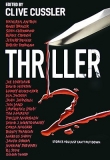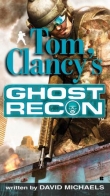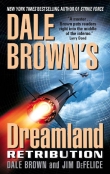
Текст книги "Ghost Fleet: A Novel of the Next World War"
Автор книги: P. Singer
Соавторы: August Cole
Жанр:
Триллеры
сообщить о нарушении
Текущая страница: 7 (всего у книги 37 страниц)
Marine Corps Base, Kaneohe Bay, Hawaii
Worm banked the F-35B hard to the left immediately after takeoff. The jet shifted smoothly into forward-flight mode, and he tried to gain some kind of situational awareness, just like they’d taught him in flight school.
The AN/AAQ-37 electro-optical distributed aperture system fed his helmet with data from visual and IR sensors located around the plane, allowing him to “see” through the plane below. And what he saw was chaos. He’d once flown through a forest fire during a training mission in California’s Sierra Nevada mountains; this was worse. All the smoke and debris in the air had created a swirl of darkness with patches of bright sun. Chinese drones darted in and out of the smoke at low levels, and on the deck, along with fragments of Marine Corps helicopters, his squadron’s fighters lay scattered about like puzzle pieces. He scanned up and around the sky and confirmed what he’d feared: his was the only U.S. jet in the air.
He started to check on the jet’s other systems. No sound came over his radios. The fighter’s GPS-coupled inertial navigation system was wrong, showing him as flying over Maui when he knew damn well this was Oahu. Electronically generated false targets flickered on the horizontal situation display and then disappeared. The plane, with its novel software systems and millions of lines of code, was designed to be its own copilot, capable of automation and interpretation never before possible in battle. But at this moment, Worm thought, the fifth-generation fighter was having trouble getting out of its own way, electronically speaking.
Marine aviators had flown for generations with just guns and guts, Worm told himself. He could do the same.
At the near corner of the airfield, he saw one of the tiny Chinese quadcopters firing, its autocannon peppering a parked Osprey tiltrotor aircraft. First, the starboard wing buckled, and then the MV-22’s massive engine dropped to the ground, tipping over the ungainly aircraft.
With one hand, Worm slowed the jet’s approach, and with the other, he targeted the quadcopter on the touchscreens before him. Then he saw her.
The defiance was unmistakable even at this distance. He magnified the image through his helmet optics, effectively creating a picture inside a picture on the screen superimposed in his cockpit. The marine fired her pistol at the drone that had rocketed the Osprey. She stood with her feet braced and leaned over the still-smoking engine to steady her aim. She fired a full magazine, then ducked down to reload.
As she drew the magazine from a pouch on her flight suit, the quadcopter dropped to within a few inches of the ground and circled back around her position. She spun around too; Worm saw her chambering the next round as she raised her weapon. He willed his jet’s cannon-arming protocol to speed up.
She fired and then darted to the other side of the wreckage, racing to keep it between her and the quadcopter, like a lethal game of musical chairs. Then she slipped in a pool of oil seeping out of the gutted Osprey, twisted her left leg, and fell down in a heap. The pistol skittered a few feet away.
“Shit!” shouted Worm.
The gun-pod light turned red. Active.
The jet shifted position slightly as Worm tried to line up the F-35’s cannon. But then the quadcopter drone rose abruptly. It had caught on to the game and was moving to gain an overhead shot on the fallen Marine.
Worm nudged the jet up using its thrust-vectoring nozzles, in effect dancing in the air. As he maneuvered to line up his gun pod, his helmet display showed the Marine crawling toward her pistol. It was lodged beneath a smoldering wing from a nearby wrecked F-35. Jesus, what balls she had, thought Worm.
His finger was already over the trigger, and he pressed down lightly, the jet buffeted as the rounds fired off. The drone opened fire at the same time as Worm’s jet loosed a line of training rounds that walked their way up the runway to the quadcopter. The image on the helmet display dissolved into an explosion of smoke and flame, and the drone spun down into the burning Osprey wreck.
Where was she?
His headset suddenly growled at him, and a flash of color danced across one of his displays. The warning from the jet’s radar-threat-detection system was unmistakable: an air-defense system was tracking him.
The readout showed that the radar that had washed over his jet wasn’t a U.S. system but an H-250 phased array, the updated Directorate mobile-SAM type.
“Oh, shit,” said Worm. “That can’t be.”
It wasn’t the threat of being shot down that chilled him despite the sweat in his flight suit. What this meant was much worse than that: they somehow already had major forces on the ground.
The Directorate armored column from the Golden Wave and Hildy Manor had bulldozed through the parked cars in the lot and left pier 29 behind; after that, the column had split, and the two lines headed off in different directions. One column of Type 99 tanks and their supporting vehicles raced off to link up with Directorate airborne troops disembarking from a trio of Harmony Airways Airbus A380s that had just landed at Honolulu International Airport. The other armored column went down the North Nimitz Highway out of town.
Worm knew where they were heading.
For all the historic value of taking Pearl Harbor, Camp H. M. Smith was the real prize. The headquarters of the U.S. military’s Pacific Command was designed to house the military’s peacetime bureaucracy, not fight off an invasion force. The Marines there would fight to the last round, Worm was certain. But there was no way they could stop a column of tanks. And then the command and control hub of the entire Pacific would be in… what? Was the right term enemy hands? It was incomprehensible.
Worm rechecked his weapons state: seventy-one rounds.
He took the plane back down for the deck and raced low across the runway. As he passed, he saw the Osprey’s wreckage, and then he saw a figure pop out from behind it. And she waved. What a warrior.
“That Marine needs to get the hell out of there,” said Worm, finding himself in conversation with his jet again, as happened when he needed to lock down his fear.
The jet’s horizontal situation display revealed a Chinese-made Z-10 attack helicopter moving in toward the runway. It wouldn’t take long for the Z-10 to discover the woman’s position, and she was clearly fool enough to start taking potshots at it. A fellow Marine needed him and he’d been taught since training that you never, ever left a Marine behind.
But there was the force headed for Camp Smith. He didn’t have enough rounds left to take the tanks out completely, but a few low passes might stall them. Maybe he could hit a command vehicle or disable the lead tank.
He eased the jet skyward and gained another five hundred feet, seeking an answer and more knots for the next strafing run.
His options were clear. His choice was not.
U.S. Navy P-8, Pacific Ocean
“Too much jamming, turn off the feed,” said Commander Bill “Sweetie” Darling. “Let’s focus on Foxglove Two, not the whole war.”
Darling couldn’t believe he’d just said war so casually. That’s what it was. America was at war in the Pacific, and he assumed elsewhere in the world. And a few minutes into the war, he could already tell that a major problem would be filtering out useful data from the flow that gushed over them as if from a fire hose.
“Understood,” said Hammer, the naval flight officer who handled the plane’s communications. “I’ll bring it back up if the jamming stops.”
Ninety miles from the formation of U.S. ships, Darling’s P-8 was on the hunt. A Type 93A submarine that had been tagged Foxglove 2 lurked somewhere nearby. The attack on Pearl Harbor was under way, but for Darling and his crew, the task was the same as it always was on patrol: find and prosecute. This particular submarine had been tailing the USS George H. W. Bush for a couple of days. Yesterday, it was just a nuisance and had added some edge to their flight ops. Today, it was an immediate threat that they had to shut down in the next few minutes or face a lifetime of knowing they had failed to protect a big-deck carrier with over four thousand sailors onboard.
Fortunately, at the moment Darling’s crew had help hunting the Directorate submarine. The USS John Warner, a Virginia-class nuclear attack submarine, was herding the submarine away from the carrier strike group into the P-8’s picket line of sonobuoys. Pinned in, Foxglove 2 would die.
The main battle-network communications feed blared into their headsets, garbled from the jamming.
“Damn it, Hammer, turn that —” said Darling.
Another voice cut him off. “Hydrophone effects. Sonobuoys just located Foxglove Two, said Hyde, one of the two crew members who handled the acoustic sensor systems. “It’s heading on a course away from the strike group, twelve knots.”
Darling nosed the P-8 over hard to get closer to the sea, pushing the throttles forward and banking the jet toward the intercept point projected on the screen in front of him. The plane’s speed edged up to almost five hundred knots as the crew counted down the seconds until they could fire on the submarine.
“At five hundred feet, releasing Mark Fifty-Four —” said his copilot, Fang Treehorn.
“Incoming, incoming. Stonefish inbound on the Bush,” interrupted Jekyll, the plane’s other sensor operator. “Goddamn NSA hackers were supposed to be able to keep those things from even getting off the ground.”
Near the horizon, faint white stalks grew skyward from the area around the Bush. The fleet’s defense systems began firing dozens of RIM-161 SM-3 missiles, designed to intercept incoming Stonefish ballistic missiles as they entered the atmosphere.
“Bush’s ATHENA shows it as twenty-six inbound. Our SAMs are countering,” Jekyll reported, giving a play-by-play of the air battle.
“Mark Fifty-Four away,” said Fang. The plane lifted slightly as the Mark 54 was released, and the torpedo splashed into the water below, its propeller already rotating toward the submarine.
The air-defense communications feed coming through the headphones suddenly became intelligible, then quickly reverted back to garbled noise. Fang had a pair of binoculars up, trying to track the dozens of air-defense missiles that raced up into the sky to meet the warheads arcing down toward the carrier and its escort ships.
“Where’d they come from?” said Fang.
“China,” said Darling.
“Yeah, asshole, I know,” said Fang. “Surprise attacks don’t have just one surprise. Think they’re nukes?”
“Nope. If it was a nuke, they’d only send one,” said Darling.
“Stonefish inbound in fifteen seconds,” said Jekyll, her drawl an attempt to hide the stress she was feeling.
“Mark Fifty-Four impact; Foxglove Two destroyed,” said Hyde.
“Ten seconds,” said Jekyll.
“Keep working the sonobuoys, Hyde,” said Darling. He felt no satisfaction from taking out the sub; the Type 93 hadn’t been the main threat after all. He felt worse than unsatisfied – he felt useless. His plane and crew were of no help at this moment.
“Wait, I got one – damn, it’s pretty close to us,” said Fang, watching through his binoculars. “And here it goes… splashdown.”
“Shit, ninety miles off target. That’s quite a miss,” said Darling. “Maybe the Stonefish isn’t the bogeyman after all.”
Fang kept staring through his binoculars.
“Fang?”
A flash on the horizon gave Darling his answer.
“Impact… impact, impact,” said Jekyll.
Darling thanked God that they were so far away from the blast, and then a wave of guilt washed over him.
“Get John Warner on the net,” said Darling, “and see how they want to help with recovery. We need to set up a sonobuoy perimeter around the task force.”
“Update from the Stockdale’s ATHENA,” Jekyll said, naming one of the escort ships. “Confirms what we saw. At least three Stonefish hit the Bush. The ship’s, um, offline now.”
“Can’t raise the John Warner,” said Hammer. “GPS is offline again.”
“Same up front. Checking Warner’s last location,” said Darling. He tried not to look at Fang, who was fiddling with his helmet and surreptitiously wiping tears away.
The P-8 was banked in a turn when Darling saw something in the water below. He squinted, willing the jet lower so he could see. Fang brought his binoculars back up even as the display screens showed the debris in detail.
“That’s too far from the task force to be from the Bush or any of the escort ships,” said Darling. “What is that? Our Directorate sub?”
“No, Foxglove Two’s last position is on the grid way over there,” said Fang, jabbing a finger at a cockpit screen.
“Shit,” said Jekyll, nervously tapping her hand on her knee. “This is the impact point for that Stonefish we saw. It didn’t miss. That’s what’s left of the John Warner.”
Marine Corps Base, Kaneohe Bay, Hawaii
The F-35 rotated its nose up and then looped over in a corkscrew twist, giving Worm one last view of the sky through the bottom of his plane.
Seventy-one rounds. Worm designated the target, feeling the jet adjust slightly.
As he arced back down toward the Osprey’s wreckage, he saw the defiant Marine pop up and begin running.
Just seventy-one rounds.
Worm found the Z-10 strafing a smoking hangar a football field away from her. One of the quadcopters saw her and raced toward her position, then hovered to beckon the helicopter over. Worm dipped the nose of the jet and eased the throttle forward. With a gentle adjustment, he rolled out and centered the helmet-mounted pipper on the Z-10. He relaxed his g slightly to stay on the target and then squeezed the trigger.
The opening burst from the F-35’s cannon went high, passed over the Z-10, and ripped apart the runway just beyond.
Forty-seven rounds.
She ran faster, not looking back even at the ripping sound in the sky behind her.
Worm fired a longer burst and the whole jet vibrated like a tuning fork. The Z-10 jerked sideways, then broke in half, spewing flame and debris in a near-perfect circle. The fuselage groaned in protest as Worm pulled back on the stick to arrest his descent.
The runner was nowhere to be seen. She had made it; he’d done his first duty: he hadn’t left a Marine behind.
Worm jammed the throttle forward to its stops and unloaded to accelerate toward Camp H. M. Smith as fast as possible. Having some American airpower overhead might give the armored Directorate column second thoughts, maybe even force it to divert to another target. He had nothing else to offer. The cannon was empty. Landing to rearm was out of the question. He’d harass the Directorate column as long as he could and then punch out somewhere up north near one of the parks.
As the F-35 accelerated away, the robotic quadcopter turned and loosed an air-to-air missile. It then blithely went back to its original task of raking the row of Ospreys on the runway.
Even before Worm heard the alarm buzz, the plane’s AN/ASQ-239 Barracuda system had automatically activated. The system’s ten tiny antennas embedded in the F-35’s wing edges began to track the enemy missile’s radar. Worm’s visor projected that it was a TY-90, a fire-and-forget missile, so even with its robot master focused elsewhere, it was still a threat. With the missile homing in on him, he pulled the F-35 hard right toward the Ulupau Crater at the end of the base. With just a little bit of luck, he thought, he’d disappear in the clutter around the old dormant volcano. He’d be damned if he was going to be the first Marine pilot to get shot down by a drone.
Worm’s fate, though, had been decided several months earlier. Six microchips had been replaced during maintenance. This was nothing unusual for a plane packed with thousands of chips that ran everything from avionics to the gun camera.
The first microchips that had powered everything from the early computers to the jet planes of the 1960s had all their components visible to the naked eye. By the turn of the twenty-first century, however, microchips packed millions of transistors into an area measured in square millimeters. And every chip was further divided into multiple subunits, called blocks, each of which carried out different functions. Much like the chips inside a smartphone, the processor in Worm’s F-35 gun camera, for example, had blocks that did everything from store frames of video to convert files.
When the microchip industry took off, it grew from just a handful of companies to more than two thousand, most of them in China, each creating twenty-five hundred new chip designs every year. These designs involved thousands of people at multiple locations, each team working on a different block, sometimes building it from scratch, sometimes contracting it out, and other times buying it from a third-party specialist. And each of those block designs was integrated into millions of chips, and those chips went into everything from toasters to Tomahawk missiles.
The result was a dangerous combination: The chips became so complex that no single engineer or team of engineers could understand how all their parts actually worked; the design process was so distributed that no one could vet all the people involved; and the chips were manufactured and bought in such great numbers that not even a tiny percentage could be tested, which almost no buyers, including the big American defense firms, even tried to do. Efficiency always beat security.
For a long time, defense analysts had worried about the notion of a kill switch – a chip that would shut down an entire computer system on command. But on Worm’s plane, the opposite happened. In each of just twelve microchips, a tiny piece of technology inside a single block woke up.
The F-35B was protected by its shape and stealth materials that shrank its radar signature to a size smaller than a metal fist. But as the Directorate missile’s radar washed over the plane, it activated a tiny antenna hidden in the ninth block of each of twelve microchips that linked Worm’s helmet-display system to the plane’s flight-control system. Even if the helmet’s manufacturers had performed a security scan when they’d bought the microchips, they still would have missed it. Each antenna was microscopic, hidden inside a one-millimeter square and activated only by a specific frequency of an incoming missile. While each antenna had just a tiny amount of energy on its own, the combination of them sent enough power to broadcast what was, in effect, a homing signal.
As Worm accelerated away, the missile picked up the signal and pursued the fighter.
Worm dove toward the palms of the Ulupau Crater in a bid to mask his plane from the missile’s radar. He grunted as the g-forces pushed him down into his seat, then he jinked hard. He should have been able to shake it. But whatever he did made no difference today; the missile followed his every move.
In his last moments, Worm glanced down at the watch his fiancée had given him for his thirty-first birthday, a Breitling Aggressor digital chronograph. It was as much to think of her one last time as it was to, like a physician, mark the time of death.
The missile rode the giveaway signal like a rail and slammed into the side of the F-35, splitting the jet into two pieces that tumbled into the Pacific.
USS Coronado, Joint Base Pearl Harbor – Hickam, Hawaii
Simmons knew the outcome of the next few moments would be a binary choice: Win or lose. Live or die.
As the Coronado pushed back from the pier, fresh air began flowing through blown-out windows and holes shot through the aluminum superstructure. Only Directorate helicopters and drones circled in the sky. One of the helicopters had just dive-bombed into the open side of the hangar deck of the USS Boxer. The amphibious assault ship, used by the Fifteenth Marine Expeditionary Unit, burst into flames, setting fire to the ship moored behind it, some kind of transport Simmons couldn’t identify.
A chainsaw-like noise and then a line of yellow tracers arcing out from the ship snapped Simmons back into focus. The Coronado’s Mk 110 gun engaged one of the smaller surveillance drones that swooped inside its line of fire.
Simmons couldn’t see any other U.S. ships moving from their moorings; that made the Coronado an even more conspicuous target.
“All ahead full. Take it to twenty-five knots,” said Simmons. “When we pass the Arizona memorial, make it forty, and then once we’re clear in the channel, flank speed. No matter what, fast as the ship can make.”
“Aye, Captain,” said Jefferson without hesitation. Good man. Normally, running a 418-foot ship at that reckless speed inside a harbor was a quick way to a brutal collision or grounding, not to mention a court-martial. But now all that mattered was escaping the harbor’s kill box.
The Coronado jerked forward, and it felt for a moment as if the trimaran’s hull was moving at a different speed than the superstructure above. Simmons hoped the ship wouldn’t come apart. Between the rocket hits and the earlier impact of the REMUS, there was no telling how much damage had been done. The squat effect of the engines’ powering lifted the bow higher than the stern, like a kid doing a wheelie on a bike, but the ship evened out as it accelerated onto a plane past the smoldering hulks of the Pacific Fleet and then the old Arizona and Missouri memorials. The first ship had already been sunk, while the second didn’t seem to have a scratch on it. The Coronado had a clear shot at one of the Directorate freighters but Simmons didn’t bother. The LCS was fast, but another wrinkle of her design was that the main gun wobbled so badly at high speeds that it wasn’t even worth the shot.
The Coronado was accelerating around the turn in the bay when the burning USS Lake Erie, a Ticonderoga-class Aegis cruiser, detonated its entire magazine. The shock wave pitched the Coronado, almost swamping the ship before the ride-control system automatically righted it. The water jets were picking up speed, though, and the ship exited the harbor at forty-eight knots, racing away as a final Directorate rocket-propelled grenade landed a hundred feet short.
“ATHENA, damage? Crew status,” Simmons barked into his command headset.
“Sys-fig ship tor ween loss,” the computer replied. “Par rew tactical ment offline ties.”
“What the hell? Cortez, damage and crew status,” Simmons said, cupping his hands around his mouth against the wind rushing through the bridge.
Lieutenant Horatio Cortez, the tactical action officer who was now the XO by default, looked over and nodded. Then the former Naval Academy water polo player seemed to stare right through his superior officer. It wasn’t fear or disrespect; he was focusing on the projections inside his Oakley tactical viz glasses. A bloody thumbprint smeared the left lens, but from the inside, he could see visuals of the ship’s data stream.
“ATHENA’s still monitoring the ship, but something in its comms hardware has been damaged. Superstructure – well, you can see that, sir. One of the diesels is leaking coolant, so we’re going to need to bring our speed down soon. Bow section has a foot of water, but it’s under control. Main gun down to fifteen rounds, and fire control is iffy. Communications are still out,” said Cortez.
“Casualties?” said Simmons, looking at the captain’s chair. The Coronado was already undercrewed by design; for the sake of efficiency, went the thinking. In peacetime, losing anyone out of the tight duty rotation was a headache. During war, it was potentially deadly to the ship and the entire crew.
“ATHENA shows twelve KIA,” said Cortez. “Eleven wounded.”
“Goddamn it,” muttered Simmons, then, realizing he’d left the headset microphone on transmit, he fumbled to shut it off.
“Where to now, sir?” asked Jefferson. Simmons could see a dark wet spot on the top of Jefferson’s head, but he wasn’t sure if it was Jefferson’s blood or someone else’s.
“Sir?” someone else quietly asked.
What now? His father had said this was what command was like, a constant stream of questions. He wheeled sharply. It was the corpsman, Cote. Shit, how could he have forgotten about the captain? Then he saw Cote’s face and realized it didn’t matter anymore.
“A moment, sir,” said Cote. “Take off your shirt.”
Simmons looked at Cote with a mix of anger and incomprehension.
“Not now,” said Simmons.
“Sir, let me do my job,” said Cote.
Simmons quickly pulled off his uniform top and felt a sharp sting behind his right shoulder blade, some kind of cut he hadn’t even realized was there.
Cote removed a small silver aerosol bottle from a waist pack and sprayed it on the wound. In an instant, the pain was gone, and Simmons could feel his shoulder relax.
“Okay, Cortez, when Cote is done, help him get Captain Riley’s body below. He doesn’t deserve this,” said Simmons. “Jefferson, let’s dip the towed-array sonar to see what’s out there. I’ll try to link with PACOM to find out what the hell they want us to do. Keep everyone at stations.”
While Simmons was tucking his shirt in, Cote studied his new captain. Without a word, the corpsman detached a hard plastic case from his belt and examined the dozens of color-coded pills inside, reverently holding the case as if it were a small Bible.
“Here, sir,” said Cote. “There’s a —”
“Just give them to me,” Simmons said, and he downed three tabs. He knew what they were by the colors: a green modafinil for endurance and focus, an orange beta-blocker to steady his nerves, and a yellow desmopressin to boost his memory and keep him from having to leave the bridge to pee.
Cote and Cortez were carrying the body toward the hatch when an alarm from the tactical display made them both stop. They left Riley’s body at the sill of the hatch and raced back to their stations.
“Ah, shit, hydrophone effects,” said Jefferson as the sonar readings started to come in. “Torpedo in the water, sir. Bearing oh-four-five. It’s close, three thousand yards.”
At that moment, Simmons realized that his first ship command would not be a long one. Of course the Directorate would leave nothing to chance. Some Type 93 sub was probably lurking at the entrance to sink any survivors who managed to make it out of Pearl Harbor. All he’d accomplished was taking the Coronado from one trap right into another.
Simmons tried to stay calm. “Bring us back up to flank speed. If they want to get us, they’re going to have to race for it.”

![Книга [Magazine 1966-07] - The Ghost Riders Affair автора Harry Whittington](http://itexts.net/files/books/110/oblozhka-knigi-magazine-1966-07-the-ghost-riders-affair-199012.jpg)






